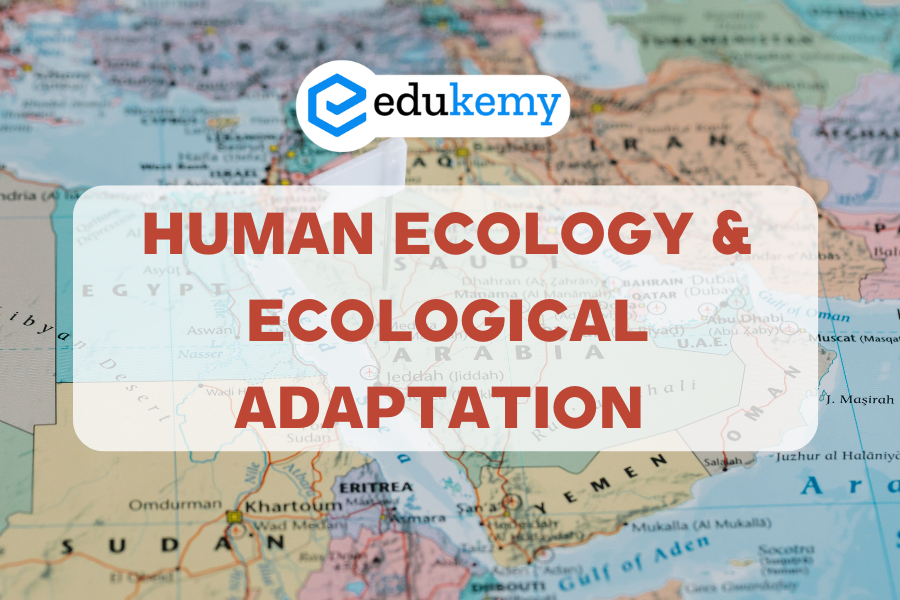Master Human Ecology & Ecological Adaptation for UPSC. Understand human-environment interactions and their significance in geography.

Contents
- 1 Introduction
- 2 Check Shabbir Sir’s Class Notes
- 3 What is Human Ecology?
- 4 What is Ecological Adaptation?
- 5 Types of Ecological Adaptations
- 6 Examples of Ecological Adaptation in India
- 7 Relevance of Human Ecology and Ecological Adaptation in UPSC
- 8 How to Prepare for Human Ecology and Ecological Adaptation
- 9 Sample Questions for UPSC
- 10 Conclusion
- 11 To get free counseling/support on UPSC preparation from expert mentors please call 9773890604
Introduction
Human ecology & ecological adaptation are fundamental concepts in geography that explore the intricate relationship between humans and their environment. For UPSC aspirants choosing Geography as their optional subject, mastering these topics is crucial as they form the backbone of human-environment interactions, a recurring theme in the UPSC syllabus. This blog will provide a detailed understanding of human ecology and ecological adaptation, along with their relevance to the UPSC exam.
Check Shabbir Sir’s Class Notes
Click Here to download
What is Human Ecology?
Human ecology is an interdisciplinary field that studies the relationship between humans and their natural, social, and built environments. It examines how human behavior, culture, and societal structures influence and are influenced by the environment. Key aspects of human ecology include:
- Human-Environment Interaction: How humans adapt to, modify, and depend on their environment.
- Resource Use and Management: The utilization of natural resources like water, soil, and forests.
- Sustainability: Balancing human needs with environmental conservation.
- Population Dynamics: The impact of population growth, distribution, and migration on the environment.
What is Ecological Adaptation?
Ecological adaptation refers to the process by which humans, like other organisms, adjust to their environment to survive and thrive. These adaptations can be biological, cultural, or technological and are shaped by environmental conditions such as climate, terrain, and resource availability.
Types of Ecological Adaptations
Ecological adaptations can be broadly classified into three categories:
1. Biological Adaptations
These are genetic or physiological changes that occur over generations to help humans survive in specific environments. Examples include:
- High-Altitude Adaptation: Populations in the Andes and Himalayas have developed larger lung capacities and higher red blood cell counts to cope with low oxygen levels.
- Skin Pigmentation: Darker skin in tropical regions protects against UV radiation, while lighter skin in temperate regions aids in Vitamin D synthesis.
2. Cultural Adaptations
These are learned behaviors and practices that enable humans to adapt to their environment. Examples include:
- Clothing: Wearing heavy fur in Arctic regions or light cotton in tropical areas.
- Agricultural Practices: Terrace farming in hilly regions (e.g., Himalayas) to prevent soil erosion and maximize arable land.
- Settlement Patterns: Compact settlements in cold regions to conserve heat and dispersed settlements in hot, arid regions.
3. Technological Adaptations
These involve the use of tools, techniques, and innovations to modify the environment for human benefit. Examples include:
- Irrigation Systems: Canals and drip irrigation in arid regions like Rajasthan.
- Housing Designs: Sloped roofs in heavy rainfall areas and thick-walled houses in deserts.
- Transportation: Use of sleds in snowy regions and boats in coastal areas.
Examples of Ecological Adaptation in India
India’s diverse geography has led to unique ecological adaptations among its populations:
- Ladakh (Cold Desert):
- Biological: High-altitude adaptations like increased lung capacity.
- Cultural: Use of woolen clothing and traditional houses with thick walls.
- Technological: Greenhouses for growing vegetables in harsh climates.
- Thar Desert (Hot Desert):
- Cultural: Water conservation techniques like building step wells (e.g., Rajasthan’s baolis).
- Technological: Use of camels for transportation and drip irrigation for agriculture.
- Northeast India (High Rainfall):
- Cultural: Stilt houses to avoid flooding.
- Agricultural: Shifting cultivation (Jhum) practiced by tribal communities.
- Western Ghats (Biodiversity Hotspot):
- Cultural: Sustainable harvesting of forest resources by tribal communities.
- Technological: Use of check dams for water conservation.
Relevance of Human Ecology and Ecological Adaptation in UPSC
- Syllabus Alignment:
- These topics are part of the Human Geography and Environmental Geography sections of the UPSC Geography optional syllabus.
- They also overlap with General Studies papers, particularly GS Paper I (Indian Society) and GS Paper III (Environment and Ecology).
- Interdisciplinary Approach:
- Human ecology connects geography with sociology, anthropology, and environmental science, making it a high-yield topic.
- Current Affairs Linkage:
- Issues like climate change, sustainable development, and disaster management often require an understanding of human ecology and adaptation.
- Case Studies:
- Questions in UPSC often demand examples and case studies. Knowledge of ecological adaptations in different Indian regions can help you write impactful answers.
How to Prepare for Human Ecology and Ecological Adaptation
- Understand the Basics:
- Start with NCERT textbooks (Class XI and XII) for foundational knowledge.
- Refer to advanced books like “Human Geography” by Majid Husain and “Environment and Ecology” by R.R. Singh.
- Focus on Case Studies:
- Memorize examples of ecological adaptations from India and the world.
- Use maps to illustrate regional adaptations.
- Integrate with Current Affairs:
- Link topics like climate change, migration, and sustainable development to human ecology.
- Practice Answer Writing:
- Write answers with diagrams, flowcharts, and case studies to make them stand out.
- For example, in a question on high-altitude adaptations, include a diagram of lung capacity changes and examples from the Andes and Himalayas.
- Revise Regularly:
- Human ecology is a conceptual topic, so regular revision is key to retaining information.
Sample Questions for UPSC
- Discuss the role of cultural and technological adaptations in human survival in extreme environments. (15 marks)
- Explain the concept of human ecology and its relevance in the context of sustainable development. (20 marks)
- Describe the ecological adaptations of human populations in the Himalayan region. (10 marks)
- How do human activities impact ecological balance? Illustrate with examples. (15 marks)
Conclusion
Human ecology and ecological adaptation are vital topics for UPSC Geography optional students, offering a holistic understanding of human-environment interactions. By mastering these concepts, you can not only tackle geography-specific questions but also enrich your answers in General Studies papers. Remember to use examples, diagrams, and current affairs linkages to make your answers comprehensive and impactful.
As you prepare for the UPSC exam, think of yourself as an ecologist—observing, analyzing, and adapting to the challenges of the exam environment. With the right strategies and consistent effort, you can turn these challenges into opportunities for success.
To get free counseling/support on UPSC preparation from expert mentors please call 9773890604
- Join Geography Optional Course – Click Here
- Get Geography Hard Copy notes – Click Here

